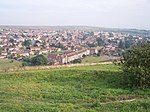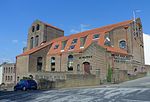Whitehawk Camp

Whitehawk Camp is the remains of a causewayed enclosure on Whitehawk Hill near Brighton, East Sussex, England. Causewayed enclosures are a form of early Neolithic earthwork that were built in England from shortly before 3700 BC until at least 3500 BC, characterized by the full or partial enclosure of an area with ditches that are interrupted by gaps, or causeways. Their purpose is not known; they may have been settlements, or meeting places, or ritual sites. The Whitehawk site consists of four roughly concentric circular ditches, with banks of earth along the interior of the ditches evident in some places. There may have been a timber palisade on top of the banks. Outside the outermost circuit there are at least two more ditches, one of which is thought from radiocarbon evidence to date to the Bronze Age, about two thousand years after the earliest dated activity at the site. Whitehawk was first excavated by R. P. Ross Williamson and E. Cecil Curwen in 1929 in response to a plan to lay out football pitches on the site. Brighton Racecourse overlaps Whitehawk Camp, and when an expansion of the course's pulling-up ground affected part of the site, Curwen led another rescue dig in the winter of 1932–1933; similarly in 1935 the area to be crossed by a new road was excavated, again by Curwen. In 1991, during the construction of a housing development near the site, one of the ditches outside the outermost circuit was uncovered, and the construction was paused to allow an excavation, run by Miles Russell. In 2011, the Gathering Time project published an analysis of radiocarbon dates from almost forty British causewayed enclosures, including several from Whitehawk Camp. The conclusion was that the Neolithic part of the site was probably constructed between 3650 and 3500 BC, and probably went out of use some time between 3500 and 3400 BC. The site was designated as a scheduled monument in 1923.
Excerpt from the Wikipedia article Whitehawk Camp (License: CC BY-SA 3.0, Authors, Images).Whitehawk Camp
Warren Road, Brighton Whitehawk
Geographical coordinates (GPS) Address Nearby Places Show on map
Geographical coordinates (GPS)
| Latitude | Longitude |
|---|---|
| N 50.8275 ° | E -0.11194444444444 ° |
Address
Whitehawk Hill Local Nature Reserve
Warren Road
BN2 3EA Brighton, Whitehawk
England, United Kingdom
Open on Google Maps










